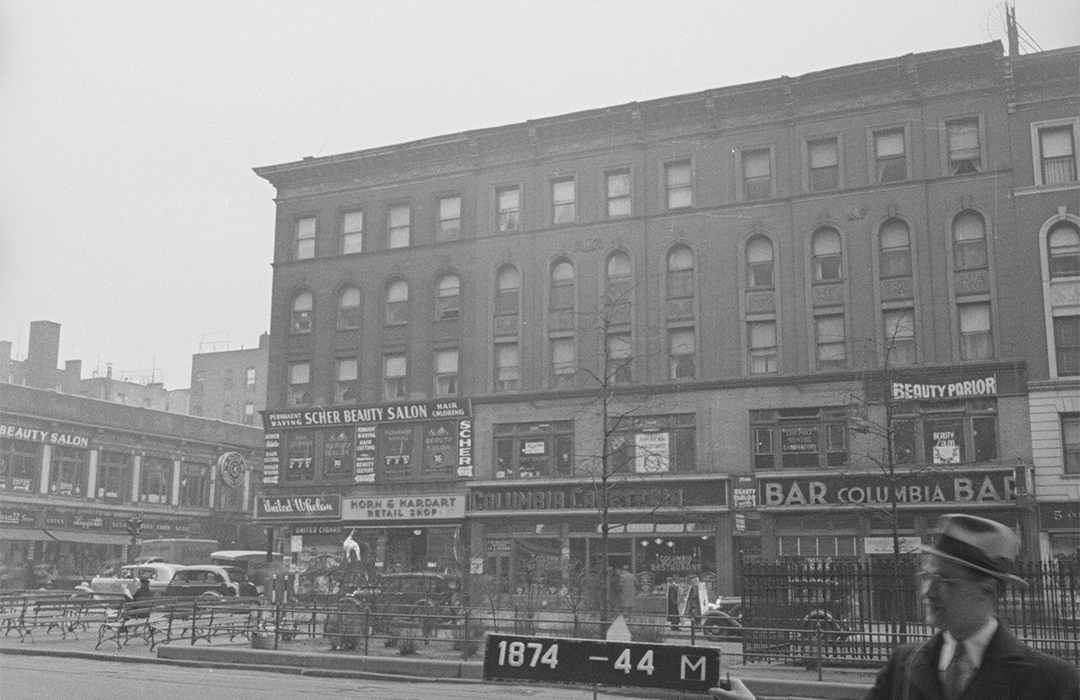
2688 Broadway
by Tom Miller
Architect Christian Steinmetz filed plans for six five-story “brownstone and brick double flats” to engulf the eastern blockfront of Broadway between 102nd and 103rd Streets on April 3, 1896. He designed them as two sets of three store-and-apartment buildings, the northern group of which were faced in brownstone above a two-story limestone base.
Like its neighbors, 2688 Broadway filled with white-collar residents. Among them was the Reverend Ernst Brenuecke, the pastor of Trinity Lutheran Church on West 100th Street. Born in Germany, he graduated from the Meine Gymnasium in 1885. While living here in 1900, he was enrolled in New York University’s graduate school, taking courses in Hebrew II and Arabic II. Breneucke would remain here at least through 1906.
Another early tenant was J. Austin Shaw. He was the owner of a substantial nursery upstate, the Eastern Editor and Manager of the Chicago-based Florists’ Review, and an amateur poet. In January 1903, he published a volume of poems titled New Century Ditties. His daughter, Lilian Austin, was a member of the Liberty Belles company, which was appearing in The Pink Pajama Girl at the time. Her father named the Lilian Austin Rose in her honor.
The 20-year-old was a soda dispenser, known colloquially as a soda jerk.
Occupying the ground floor by 1913 was Charles Haberman’s florist shop. He would remain in the space at least into the 1920s.
By the Depression years, the affluence and, in some cases, the respectability of the tenants had declined. Herbert Siogle lived here in 1936. The 20-year-old was a soda dispenser, known colloquially as a soda jerk. On the night of May 20, according to The New York Post, “He had played traitor to his profession…what he had been drinking came from no soda fountain.” Indeed, Sigole was highly intoxicated when he stumbled into the Pure Food Restaurant at 2656 Broadway after the bars closed.
Nathan Lippy, a 28-year-old bouncer from the Silver Slipper dance hall on 48th Street, and three of his co-workers were already in the restaurant. As Siogle passed their table, he took food off one of their plates. Understandably, an argument followed.
The New York Post reported, “Two women, friends of Lippy, came in and joined the party. Siogle did not allow their presence to interfere with his remarks, and the gallant dance hall bouncer warned him not to swear in front of ladies.” The rebuke did not sit well with the drunken Siogle. The New York Sun wrote, “Siogle then ran to the kitchen and grasped a bread knife.” He rushed back to the table and stabbed Lippy several times in the side. Lippy died at the hospital shortly afterward. Siogle was arrested and charged with homicide.
The Haberman flower shop was replaced by the Elkwood Delicatessen and Restaurant by 1929. In 1937, with Prohibition having been repealed for four years, the Elkwood got its liquor license. It was replaced, however, the following year by The Knitting Studio, which offered “cut rate yarns” and free knitting classes.
Major change came in 1945 when the upper floors were converted to a single-occupancy-room hotel. The former shop space became the headquarters of the American Labor Party in the late 1940s and early ‘50s. Its actions were closely scrutinized by 1949 Senate hearings on Communist Activities Among Aliens and National Groups.
“…the gallant dance hall bouncer warned him not to swear in front of ladies.”
As the 21st century neared, the former flop house attempted to reform, rebranding itself the Malibu Studios Hotel. On December 18, 1992, The New York Times distilled its assessment into a single sentence: “More of a glorified rooming house than a hotel, this student-oriented residence 12 blocks from Columbia University offers clean, spartan accommodations (with shared baths) for rock-bottom rates.”
The Malibu Studios became the Marrakech Hotel around 2014. That year Eyewitness Travel’s Family Guide New York City wrote frankly, “The Moorish décor doesn’t disguise the fact that this is a basic, slightly scruffy budget choice with no elevator and little space. That said, rooms have private bathrooms, Wi-Fi is free in the lobby, the neighborhood is good, and a subway station is on the corner.”
The end of the line for the Marrakech Hotel came when permits were granted in 2020 to demolish Christian Steinmetz’s three 1897 buildings. They were razed to make way for The Rockwell, a 15-story apartment building.
Tom Miller is a social historian and blogger at daytoninmanhattan.blogspot.com


